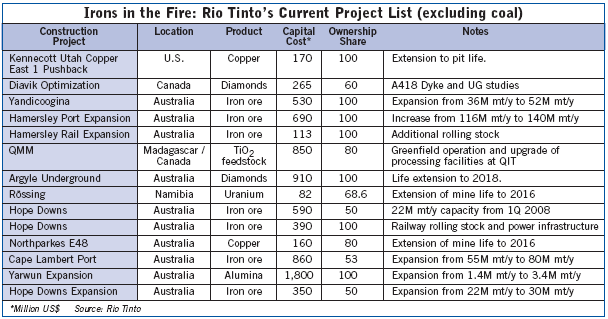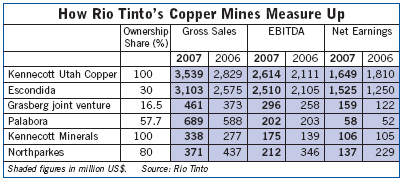
Selloff: Rio Tinto Sheds Mining Properties as it Fights Billitonís Takeover Bid

In November 2007, BHP Billiton made an unsolicited takeover bid to acquire Rio Tinto, offering three BHP Billiton shares for each Rio Tinto share. The Rio Tinto boards unanimously rejected the proposal, saying that it significantly undervalued Rio Tinto and its prospects. On February 6, 2008, BHP Billiton made an another bid, this time offering 3.4 BHP Billiton shares for each Rio Tinto share for a total valuation of about $147 million, which also was quickly rebuffed by Rio Tinto.
However, by not labeling its most recent bid as final, BHP Billiton left the door open to possibly make another offer that would most likely have to be significantly higher, particularly after Aluminum Co. of China, also known as Chinalco—China’s largest aluminum company—and Alcoa teamed up to buy a 12% share of Rio Tinto in early February, paying an equivalent of about 4.1 BHP Billiton shares for each Rio Tinto share in a transaction valued at about $14.05 billion. The deal reportedly was the largest ever overseas investment by a Chinese company. Alcoa said it contributed $1.2 billion to the buy-in.
Cortez Sold…
Meanwhile Rio Tinto, which plans to divest
itself of about $15 billion in noncore business
assets in the near future, reportedly is
considering sales of its North American
coal operations and talc business, the
Northparkes copper mine in Australia, and
uranium assets in the U.S. and Australia
along with its packaging and engineered
aluminum products groups.
The largest sale so far has been to Barrick Gold Corp. which announced on February 21 that it had entered into a definitive purchase and sale agreement with Kennecott Explorations (Australia) Ltd., a subsidiary of Rio Tinto plc, to purchase its 40% interest in the Cortez Joint Venture in Nevada, for a cash cost of $1.695 billion. The transaction is expected to be completed by the end of the first quarter of 2008, subject to customary closing conditions.
The acquisition will increase Barrick’s share of proven and probable reserves by 4.6 million oz to 11.5 million oz (100% basis) and measured and indicated mineral resources by 1.4 million oz to 3.5 million oz. The Cortez Joint Venture comprises the Cortez mine and the Cortez Hills development project.
When the Cortez Hills project is commissioned, the Cortez property is expected to become a significant contributor to Barrick’s Nevada production base, with average annual production between 950,000–1 million oz of gold at total cash costs of $280–$290/oz in the first full five years of production.
Barrick said it would be entitled to the production and economic benefit of the remaining 40% interest in the property effective on March 1, 2008.
“Nevada remains a key focus of our exploration dollars and we see excellent potential on the Cortez property, which shares many of the geological characteristics of our Goldstrike mine,” said Alex Davidson, executive vice president of exploration and corporate development.
Terms of the acquisition also include a sliding scale gross royalty on 40% of all future production in excess of 15 million recovered ounces from January 1, 2008. A further conditional lump-sum payment of $50 million will be payable in cash if and when Barrick adds an additional 12 million oz of contained gold resources to the December 31, 2007, reserve statement for Cortez.
Barrick acquired its 60% interest in Cortez through its acquisition of Placer Dome in March 2006. In 2007, the joint venture focused on advancing the Cortez Hills project and spent $88 million for open-pit mining equipment, project infrastructure engineering, installation of dewatering wells, and completion of an additional 439 m of the underground exploration decline. Detailed engineering is substantially complete, and permitting is expected to be complete in the second half of 2008. Cortez Hills is expected to enter into production within 15 months of the Record of Decision becoming effective. Barrick said capital costs for Cortez Hills are currently on budget and are estimated to be $480–$500 million.
The Cortez property is located approximately 60 miles south of Barrick’s flagship Goldstrike property. Barrick’s other mines in Nevada include Bald Mountain, Ruby Hill, Turquoise Ridge (75%), Round Mountain (50%), and Marigold (33%).
The Cortez purchase wasn’t Barrick’s only big news during the month. On February 27, Barrick announced that Pueblo Viejo Dominicana Corp. (PVDC), a company jointly owned by Barrick (60%) and Goldcorp Inc. (40%), submitted a feasibility study and the project notice to the Government of the Dominican Republic in order to proceed with the Pueblo Viejo project. Pueblo Viejo is a gold mining project located about 100 km northwest of Santo Domingo in the Sanchez Ramirez province and would represent the largest foreign investment in the country.
The Pueblo Viejo feasibility study estimates that construction capital requirements would be approximately $2.7 billion— which represents an increase from the $2.1- to $2.3-billion estimate of February 2007, mainly from a throughput rate increase to 24,000 mt/d from 18,000 mt/d. Production is projected to be almost 1 million oz/y of gold during the first full five years of production.
Proven and probable reserves for Pueblo Viejo as of December 31, 2007, were estimated to contain 20.4 million oz of gold, along with 423.6 million lb of copper and 117.3 million oz of silver contained within the gold reserves.
The project is expected to create roughly 3,500 jobs during a 3.5-year construction phase, along with 1,000 jobs when the mine begins operation. Life of mine is currently estimated to be about 25 years. According to Barrick, the project also would include plans to clean up environmental damage from a previous operation.
…and Greens Creek…
Earlier, on February 12, Hecla Mining Co.,
which owns 29.7% of the Greens Creek
polymetallic mine in southeastern Alaska,
reported that it would purchase all of the
equity of the Rio Tinto subsidiaries that
hold the remaining 70.3% interest in
Greens Creek. The $750-million purchase
price will comprise $700 million in cash
and $50 million in Hecla common stock.
Hecla said it has received $400 million in
debt financing from Scotia Capital, which
together with available cash will be used to
fund the acquisition. Closing is expected to
occur in the second quarter.
In 2007, on a 100% basis, Greens Creek produced approximately 8.6 million oz of silver, 68,000 oz of gold, 63,000 tons of zinc and 21,000 tons of lead. Because of the current value of the mine’s by-product metals more than pay for the silver production, the total average cash cost of silver was negative $5.27/oz. Even at metals prices significantly lower than they are today, Hecla estimates a 10-year average cash cost of $1.88/oz of silver at Greens Creek.
Hecla has been a joint venture partner in the mine since 1987, and during a conference call with analysts on February 12 Hecla President and CEO Phil Baker noted that there had been “numerous occasions” when Hecla had looked for ways to acquire full interest in the mine. “Things finally came together in the past few months,” said Baker. “Our financial capabilities came together with Rio Tinto’s willingness to part with this asset.”
Labeling the purchase a “company transforming transaction,” Baker said the acquisition would change the nature of Hecla “because of what it does to our production and our costs, and what it does to us relative to other companies in the sector. It further improves our position as the lowest cost silver producer.
“We also see [Greens Creek] as being one of the best exploration properties in the silver sector,” said Baker. “It’s been in operation more than 20 years, we have ten years of reserves on the books, and we think we’ll grow that.”
Baker noted that the acquisition would double Hecla’s silver production to more than 11 million oz/y, increase silver reserves by about 150% and gold by 140%, and increase cash flow significantly.

KUC’s 2007 production of refined copper rose to 292,800 tons, exceeding 2006 levels of 240,200 tons for a 22% increase. Gold production totaled 523,000 oz in 2007, a 7% increase that surpassed the previous record level of 488,000 oz in 2002. Silver output was up 5% to 4.3 million oz in 2007, also eclipsing the previous record of 4.1 million oz set in 2006.
KUC said it expects a bulk flotation modernization program under way at its Copperton concentrator to be completed during the second quarter of 2008, and is currently conducting a pre-feasibility study to evaluate future growth options at the Bingham Canyon operation, where potential pit expansions and underground operations could extend the mine’s life to 2036.